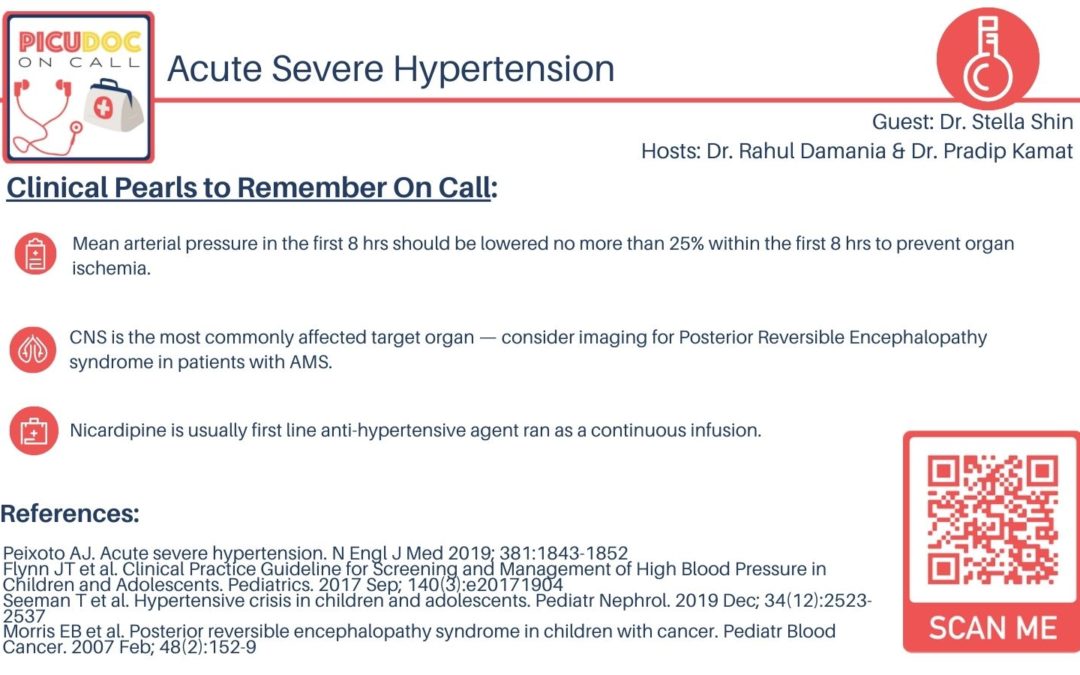Today, we welcome Dr. Stella Shin, Assistant Professor of Pediatrics-Pediatric Nephrology at The Emory University School of Medicine. Dr Shin is also the Director of General Pediatric Nephrology and the Director of Acute Kidney Replacement Therapy at The Children’s Healthcare of Atlanta in Atlanta, GA. Her interests include nephrotoxic medication stewardship, health informatics and healthcare quality improvement. She is on twitter @BabyBeanDoc
A 17 year old previously healthy thinly built male teenager is brought to the emergency department for sudden development of blurred vision. Patient has a h/o headaches for the last few months accompanied by abdominal pain and relieved by vomiting. He has also felt his heart racing during such episodes and accompanied by profuse sweating. Patient had tried various over the counter pain medications without much improvement in his headaches or abdominal pain. An initial CT scan of the head reveled no intracranial pathology. ED physician noted a a blood pressure of 200/120 mm HG and a pulse of 132beats/minute. He is started on nicardipine in the ICU.
- Definitions for normal and high blood pressure come from the AAP clinical practice guidelines for screening and management of high blood pressure. According to these guidelines:
- Normal BP is a blood pressure reading that is < 90%ile for children 1-12 yrs of age: A normal BP for teenagers 13 years and older = <120/<80.
- High blood pressure is divided into three categories: Elevated BP, Stage 1 HTN, and Stage 2 HTN. This is further delineated into categories for children 1-12 yo and 13 or older.
- For children 1-12 yo:
- Elevated BP is a BP that is >/= 90%ile but <95%ile, or a BP of 120/80 up to <95%ile, whichever is lower.
- Stage 1 HTN is a BP that is ≥95%ile to <95%ile+12 mmHg, or a BP of 130/80 to 139/89, whichever is lower.
- Stage 2 HTN is a BP that is ≥95%ile+12 mmHg, or a BP that is ≥140/90, whichever is lower.
- It’s much more simple for children 13 and older:
- Elevated BP is 120/<80 to 129/<80
- Stage 1 HTN is 130/80 to 139/89
- Stage 2 HTN is >/= 140/90
- That’s a lot of numbers and cut offs to remember. To make it easy, in general, hypertension in children and adolescents is defined as a sustained systolic and/or diastolic blood pressure elevation ≥ 95%ile for age, gender, and height. And adult BP cut offs are used for teenagers 13 years or older.
Acute severe hypertension is defined as significant blood pressure elevation with or without of acute target-organ damage from the hypertension.
This is further classified based on target organ involvement into hypertensive urgency and hypertensive emergency. The key difference between the two is whether target organ injury is present.
Hypertensive Urgency is acute severe hypertension WITHOUT acute target-organ damage. Hypertensive urgency is not associated with adverse short-term outcomes and can be managed in the ambulatory setting.
Hypertensive Emergency is acute severe hypertension that is accompanied by acute target-organ injury. It is a medical emergency with substantial morbidity and mortality requiring immediate treatment in an ICU.
It is important to note for our listeners that acute sever hypertension is on a spectrum with hypertensive urgency and emergency, and these diagnoses exist on a spectrum!
Our discussion focused on acute severe hypertension, which is a medical emergency especially when there is target organ injury. A titratable infusion of an antihypertensive such as nicardipine should be the first line to lower the BP by 25% in first 8 hours as precipitous drop may cause cerebral ischemia. While there are multiple IV antihypertensives, the pediatric critical care team should be should be aware of the pharmacology and relevant side effects of these agents in efforts to choose the best drug for the patients condition. Early consultation with nephrology is warranted in these patients along with monitoring of end organ function.

